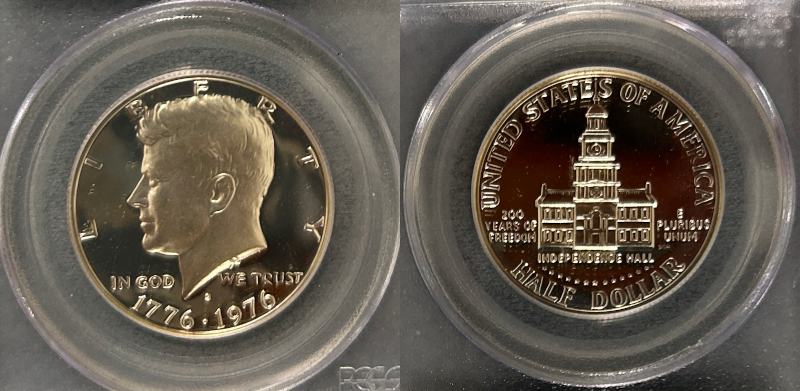I’ve loved collecting coins ever since I started hoarding my parents’ old pocket change as a child. I think it was the intersection of law, politics, history and art that appealed to me. That, and I figured coins were a good investment (they’ll always be worth something, right?).
Despite that, my interest in numismatics has waned over the last decade. The Great Recession inflated the price of silver and gold, making it difficult for me to acquire new coins to add to my already large collection.
For personal reasons (as well as the fact that silver prices have gone down), I’ve been getting back into the hobby as of late. In trying to learn more about the coins I already have, as well as the ones I’ve recently acquired, I figured I might as well write about them. So here we go…

Like many collectors who came of age in the 80s and 90s, my introduction into coin collecting came with bicentennial coins. There was something thrilling about seeing those quarters with the colonial drummer on the reverse instead of the usual eagle and then hoarding them as if they were valuable collectors’ items and the key to early retirement. Little did I know that they were barely worth more than regular (non-silver) quarters.
Of course, that’s not to say that they weren’t worth collecting. After all, we all need to start somewhere and because so many bicentennial coins were minted, they’re relatively affordable (even the silver clad ones) and easy to find. They were perfect starter coins for people of my generation, and they’re a good second level for today’s novice collectors once they’ve filled their state quarter albums.
Authorized in 1975, bicentennial coins marked the first time the U.S. government had issued a commemorative coin since the 1950s. Previously, the mint had released all kinds of commemorative coins — many of which are highly collectible today (indeed, some of my favorite coins in my collection are from that era). Unfortunately, many of them were of dubious merit and were pushed through Congress by a powerful politician seeking to raise money for projects back home. For instance, in 1936 there were no fewer than 19 such coins issued for such momentous events as the centennial of the founding of Elgin, one of the ten largest cities in Illinois (established in 1835, meaning the released coin actually commemorated the 101st anniversary), a second commemorative coin celebrating Arkansas’s centennial (featuring the portrait of the still-living Senate Majority Leader, Joe Robinson, in violation of federal law), and a Cincinnati music center coin featuring a composer (Stephen Foster) that has, historically, been associated more with Pittsburgh.

The other precedent working against bicentennial coins came in 1926, when the country celebrated its sesquicentennial. Featuring images of George Washington and then-current president Calvin Coolidge on the obverse, the sesquicentennial half dollar was another coin that broke the law against depicting living individuals on it. Of course, that was hardly the biggest problem. The coin was poorly struck and was not popular with the public, receiving an underwhelming reception when it was unveiled at the Sesquicentennial International Exposition held in Philadelphia that year.
After several false-starts and changed minds, the bill authorizing the bicentennial coins was finally signed into law by President Richard Nixon on October 18, 1973. Interestingly, two days after signing this bill, Nixon would order his attorney general to fire the special prosecutor investigating Watergate, triggering the Saturday Night Massacre and unleashing a constitutional crisis. Nixon would, of course, resign in 1974 – a year before the coins he authorized would hit the market.
Instead of issuing new coins (including a $25 gold piece proposed by Senator Mark Hatfield of Oregon), the mint would simply put new images on the reverse side of the quarter, half dollar and dollar. Opening up the process to the public, the mint announced a contest to determine the reverse designs. Of the finalists, a judging panel selected the designs we now know and love: the colonial drummer for the quarter, Independence Hall for the half dollar and Liberty Bell superimposed over the moon for the dollar.

Anyway, I recently picked up three proof bicentennial coins (quarter, half dollar and dollar) — all graded deep cameo. I love the frosted finish on the obverse portraits, although it’s less conspicuous on Ike’s bust compared to Washington’s and Kennedy’s. I guess there’s something poetic about re-igniting my love of coin collecting by acquiring different types of the very coins I started my collection with.
Additionally, it gives me a chance to speculate as to what the semiquincentennial commemorative coin might look like. Maybe a quarter reverse featuring the signing of the Declaration of Independence? Or a half dollar reverse featuring the Sons of Liberty dumping tea into the Boston Harbor? Or a dollar coin with the words: “This is not a quarter! And minting coins is cheaper in the long run than printing bills!” emblazoned on the back? The possibilities are endless…

